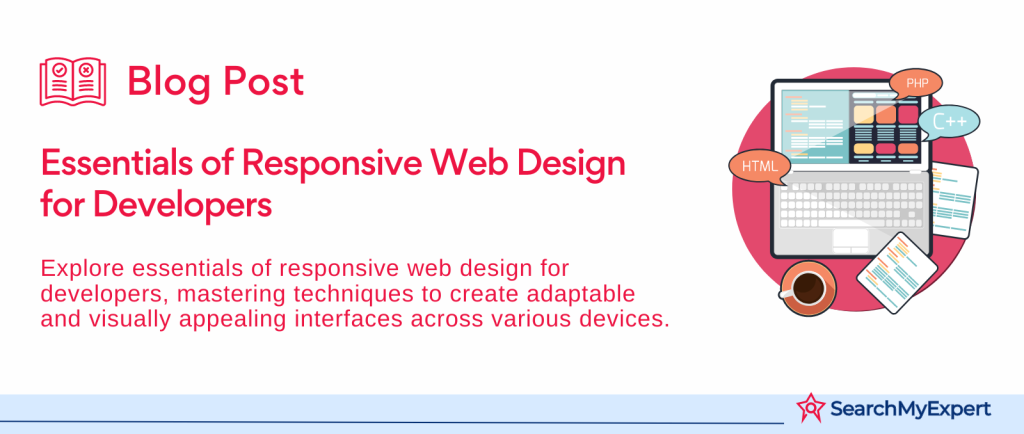Introduction to Responsive Web Design (RWD)
In today’s rapidly evolving digital world, the significance of Responsive Web Design (RWD) cannot be overstated. RWD is a design approach that ensures a website’s layout adjusts seamlessly to the varying screen sizes and resolutions of different devices, such as desktops, tablets, and smartphones. This adaptability is crucial in a landscape teeming with diverse devices, each with its unique display capabilities.
Understanding the Essence of RWD
Responsive Web Design is anchored in the concept of fluid grids, flexible images, and media queries. The core principle is straightforward yet powerful: create web pages that detect the visitor’s screen size and orientation, then change the layout accordingly. This flexibility is vital in a world where a single website could be accessed from a 4-inch smartphone, a 10-inch tablet, or a 27-inch desktop monitor.
The Multifaceted Benefits of RWD
The benefits of adopting RWD are manifold, both for users and developers:
- Enhanced User Experience: RWD eliminates the need for tedious scrolling and resizing when accessing a website from different devices, offering a smooth and user-friendly experience.
- Increased Reach to Mobile Audience: With the upsurge in mobile device usage, RWD enables websites to cater effectively to a broader audience.
- Cost-Effectiveness:
RWD allows for a single website design that works across various devices, reducing the need for multiple versions of a site. - Improved Search Engine Rankings: Google and other search engines favor mobile-friendly websites, and RWD is a key component in achieving mobile compatibility.
- Ease of Maintenance:
Managing one responsive website is far simpler and less time-consuming than maintaining separate sites for desktop and mobile audiences.
Navigating the Challenges and Best Practices
Despite its advantages, RWD does come with its set of challenges. Design complexity, performance considerations, and testing across numerous devices are some of the hurdles faced by developers. However, adhering to best practices such as mobile-first design, optimizing images, and using flexible grids and layouts can mitigate these challenges effectively.
Understanding the Role of PHP in Responsive Design
Responsive Web Design (RWD) primarily focuses on client-side adjustments to ensure a website’s compatibility with various devices. However, the server side, particularly PHP, plays a pivotal role in enhancing and facilitating RWD. PHP, a server-side scripting language, contributes significantly to RWD, extending beyond its traditional scope of backend development.
PHP: Beyond Server-Side Scripting
PHP’s contribution to RWD is often underestimated. It’s widely recognized for backend development, but its impact on responsive design is profound:
- Dynamic Content Delivery: PHP excels in delivering content tailored to the user’s device. By detecting the user’s device type and screen size, PHP can serve different versions of content, optimized for specific devices.
- Efficient Image Handling:
PHP aids in server-side image resizing and compression. Instead of relying on the client’s browser, images can be resized and optimized on the server, enhancing loading times and overall performance on smaller devices. - Enhanced Cache Management:
PHP can be used to manage caching strategies effectively, ensuring that mobile users receive the most updated content without unnecessary delays.
Integrating PHP with Responsive Frameworks
Frameworks like Bootstrap and Foundation have revolutionized RWD. Interestingly, these frameworks can be integrated with PHP to create a more efficient and dynamic user experience:
- Bootstrap and PHP:
Bootstrap, known for its responsive grid system and pre-designed components, can be dynamically controlled using PHP. This integration allows for the creation of responsive elements based on server-side logic. - Foundation and PHP:
Similar to Bootstrap, Foundation offers a robust framework for RWD. PHP can be used to customize Foundation components, tailoring the user experience based on server-side data.
Server-side component Resizing and Dynamic Content Delivery
PHP’s role in server-side component resizing and dynamic content delivery is crucial:
- Server-Side Component Resizing:
PHP can dynamically resize website components such as navigation menus or sidebars based on the user’s device. This ensures that the website layout remains intuitive and user-friendly, irrespective of the device. - Dynamic Content Delivery:
PHP can serve different content or layouts based on the user’s device. For instance, a complex, multi-column layout can be transformed into a single-column layout for mobile users, with PHP determining the best layout to serve.
Building a Responsive Layout with HTML and CSS
In the realm of web design, the creation of a responsive layout is fundamental. This necessitates a harmonious blend of HTML and CSS, ensuring that websites not only look appealing but also function seamlessly across various devices. Let’s explore how to craft a responsive layout using these essential tools.
Prioritizing Clean and Semantic HTML
The foundation of a responsive website lies in its HTML structure. The importance of clean and semantic HTML cannot be overstressed:
- Structural Clarity:
A well-organized HTML structure makes it easier for CSS to apply styles effectively, essential for responsive design. - Semantic Elements:
Using semantic elements like <header>, <footer>, <nav>, and <article> provides meaningful structure, aiding both in SEO and accessibility. - Enhanced User Experience:
Clean HTML ensures a smoother experience for users, as it helps browsers and assistive technologies to better interpret the content.
Leveraging CSS for Fluid Layouts
CSS is the tool that brings the HTML structure to life, adapting it to various screen sizes. Key techniques include:
- Media Queries:
These are the cornerstone of responsive design, allowing different styles to be applied based on various conditions like screen width, height, and orientation. - Flexbox:
Flexbox simplifies designing flexible layouts without having to use float or positioning hacks. It’s great for aligning items within a container and managing space distribution in a way that responds to screen size changes. - CSS Grid Layout: This technique provides a more robust and controlled way to create responsive layouts. It allows for designing complex layouts that are both responsive and maintainable.
Responsive Media and Typography
A responsive design also needs responsive media and typography:
- Responsive Images:
Implementing responsive image scaling is crucial. This can be achieved through CSS with properties like max-width: 100% and height: auto; to ensure images scale correctly on different devices. - Adaptive Typography:
Typography should be flexible. Using relative units (like ems, rems, or viewport percentages) for font sizes ensures that text scales appropriately across devices. - Viewport Units for Fluid Sizing:
Viewport units (vw, vh, vmin, vmax) are incredibly useful for creating typography and elements that adjust size based on the browser’s viewport dimensions.
Enhancing Interactivity with JavaScript in Responsive Web Design
Responsive Web Design (RWD) sets the stage for a versatile viewing experience across different devices. However, to elevate this experience to the next level, incorporating JavaScript is key. JavaScript breathes life into RWD, making web pages not just visually adaptable but also interactively dynamic.
JavaScript: The Catalyst for Dynamic Interactions
JavaScript’s role in RWD extends beyond mere structural adjustments, venturing into the realm of enhanced user experience:
- Smooth Animations:
JavaScript allows for the creation of fluid, responsive animations that adapt to various screen sizes, enriching the user interface without compromising performance. - Interactive Elements:
JavaScript enables interactive components like sliders, tabs, and models that respond to user actions, providing a seamless experience across devices.
Responsive Navigation Menus and Image Galleries
Two common elements where JavaScript significantly contributes to responsiveness are navigation menus and image galleries:
- Responsive Navigation Menus:
In mobile views, navigation menus often transform into hamburger menus or dropdowns for better usability. JavaScript enables this transformation and ensures that these menus are responsive to user interactions like clicks or taps. - Dynamic Image Galleries:
JavaScript allows for the creation of responsive image galleries that can adjust their layout and size based on the viewing device. This includes features like touch-enabled swiping for mobile devices, which enhances the browsing experience.
Touch Event Handling and Mobile-Specific Optimizations
In a mobile-first approach, JavaScript’s ability to handle touch events is crucial:
- Touch Event Handling:
JavaScript provides the ability to handle touch events like swipe, pinch, and zoom, which are essential for mobile users. This makes the website not only responsive in layout but also in interaction. - Mobile-Specific Optimizations: JavaScript can be used to detect the device type and load mobile-specific scripts or features, optimizing the site’s performance and usability on mobile devices.
- Conditional Loading:
JavaScript can conditionally load resources depending on the device or screen size, thus enhancing the site’s performance by not loading unnecessary resources on mobile devices.
Integrating PHP Components for Dynamic Content in Responsive Web Design
Responsive Web Design (RWD) ensures that a website’s layout adapts to different screen sizes, but it’s the dynamic content generation where PHP truly shines. PHP, a server-side scripting language, can be used to tailor content based on the user’s device, offering a more personalized and efficient browsing experience. Let’s explore how PHP can be integrated into RWD to enhance functionality and user engagement.
PHP for Dynamic Content Generation
PHP’s ability to generate dynamic content is particularly useful in RWD for several reasons:
- Device-Specific Content:
PHP can detect the user’s device type and screen size, allowing for the creation of content specifically optimized for that device. This can include altering image sizes, changing layout components, or even serving different content altogether. - Enhanced Performance:
By serving device-appropriate content, PHP can help reduce load times and data usage, especially important for mobile users with limited bandwidth.
Responsive Menus Powered by PHP
Navigation is a crucial aspect of any website, and PHP can significantly enhance its responsiveness:
- Dynamic Menu Generation:
PHP can dynamically generate navigation menus based on user preferences, device type, or other criteria. This can range from altering the menu layout to displaying different menu items entirely. - Database-Driven Menus: With PHP’s ability to interact with databases, menus can be created based on database queries, allowing for real-time updates and personalized user experiences.
Conditional Display and Content Tailoring Techniques
PHP is adept at conditionally displaying elements and tailoring content, which is essential for responsive design:
- Conditional Display of Elements:
PHP can be used to show or hide certain elements based on the device or other user-specific conditions. This helps in creating a cleaner and more focused user interface for different devices. - Content Tailoring:
PHP can customize the content served to users based on their device, location, or browsing history. This level of personalization enhances user engagement and satisfaction. - Adaptive Content Loading: PHP can selectively load content, such as heavier images or videos, based on the device’s capabilities, ensuring that the website remains efficient and responsive.
Optimizing Performance for Various Devices in Responsive Web Design
In Responsive Web Design (RWD), performance optimization is crucial, especially considering the diverse range of devices accessing the web. This optimization is vital for enhancing user experience, improving search engine rankings, and ensuring the overall success of a website. Let’s delve into strategies for optimizing performance across various devices, with a special focus on mobile devices.
Prioritizing Page Load Times for Mobile Devices
The importance of optimizing page load times for mobile devices cannot be overstated:
- User Experience:
Mobile users often have less patience and slower internet connections. Optimizing load times improves user satisfaction and engagement. - SEO Benefits:
Search engines, like Google, prioritize mobile-friendly websites in their ranking algorithms. Faster load times on mobile devices can lead to better search rankings.
Mobile-First Development Principles
Adopting a mobile-first approach is key in RWD:
- Progressive Enhancement:
Start with a basic layout and features for the smallest screens, then progressively add more complex features and layouts for larger screens. - Minimalistic Design: Keep the design simple and uncluttered for mobile users, focusing on essential content and functionality.
Responsive Image Optimization Techniques
Images often account for the most significant portion of page load times, especially on mobile devices:
- Adaptive Image Sizing:
Use different image sizes for different devices. This can be achieved using HTML’s <picture> element or CSS’s srcset attribute. - Image Compression: Compress images without losing quality to reduce their file size. Tools like TinyPNG or ImageOptim can be used for this purpose.
- Lazy Loading: Implement lazy loading for images, where images only load as they are about to enter the viewport.
Caching Mechanisms and Efficient PHP Execution
Optimizing backend processes is equally important:
- Caching Strategies:
Implement server-side caching to reduce load times. Techniques include object caching, database query caching, and full-page caching. - Efficient PHP Code:
Write clean, efficient PHP code. Use PHP’s latest version for better performance, and optimize database queries to reduce server load and response time. - Content Delivery Networks (CDN):
Use a CDN to serve static resources like images, CSS, and JavaScript files. CDNs reduce latency by serving content from the nearest server to the user’s location.
Testing and Troubleshooting for Responsive Designs
Ensuring that a website functions flawlessly across a spectrum of devices and browsers is a critical phase in Responsive Web Design (RWD). Testing and troubleshooting are indispensable processes that validate the effectiveness of a design, identify potential issues, and guarantee a consistent user experience. Let’s explore the methodologies and tools essential for this phase.
The Imperative of Cross-Device and Cross-Browser Testing
Testing across various devices and browsers is fundamental:
- Diverse Device Landscape:
With an array of devices in use, each having different screen sizes and resolutions, testing ensures compatibility and a uniform experience. - Browser Variations:
Different browsers interpret web standards in their own way. Cross-browser testing is essential to ensure that a website looks and functions correctly across all major browsers.
Leveraging Developer Tools and Emulators for Responsive Testing
Developer tools and emulators are invaluable assets:
- Browser Developer Tools:
Modern browsers like Chrome, Firefox, and Safari come equipped with developer tools that include responsive design modes. These tools allow developers to simulate a range of screen sizes and resolutions. - Emulators and Simulators:
Tools like BrowserStack or emulators in Android Studio and Xcode enable testing on virtual devices, providing an approximation of how websites will look and function on various devices and operating systems.
Debugging Layout Issues and Adapting to Device Limitations
Effective troubleshooting techniques are key:
- Debugging CSS and JavaScript: Use the console and debugging tools in browsers to inspect elements, test different CSS properties, and debug JavaScript issues.
- Media Query Inspector:
Some developer tools have media query inspectors, which are useful for debugging CSS media queries and ensuring that the correct styles are applied at different breakpoints. - Performance Testing:
Tools like Lighthouse and WebPageTest help identify performance bottlenecks, especially important for mobile devices with slower connections. - Device-Specific Testing: Test on actual devices whenever possible, as this provides the most accurate representation of user experience, particularly for understanding touch interactions and mobile performance.
- Network Conditions Simulation:
Simulate various network conditions to understand how your website performs under different data speeds, an essential aspect for mobile users.
Conclusion:
Mastering Responsive Web Design is a journey through various web technologies and design strategies. This comprehensive guide has traversed the essential aspects of RWD, starting from its core principles, the integration of HTML and CSS for fluid layouts, to the dynamic interactivity added by JavaScript. We delved into the role of PHP in responsive design, discussed optimizing website performance for different devices, and underscored the importance of thorough testing and troubleshooting.
Transform your digital presence with PHP Development Service Firms.
Table of Contents
Toggle






